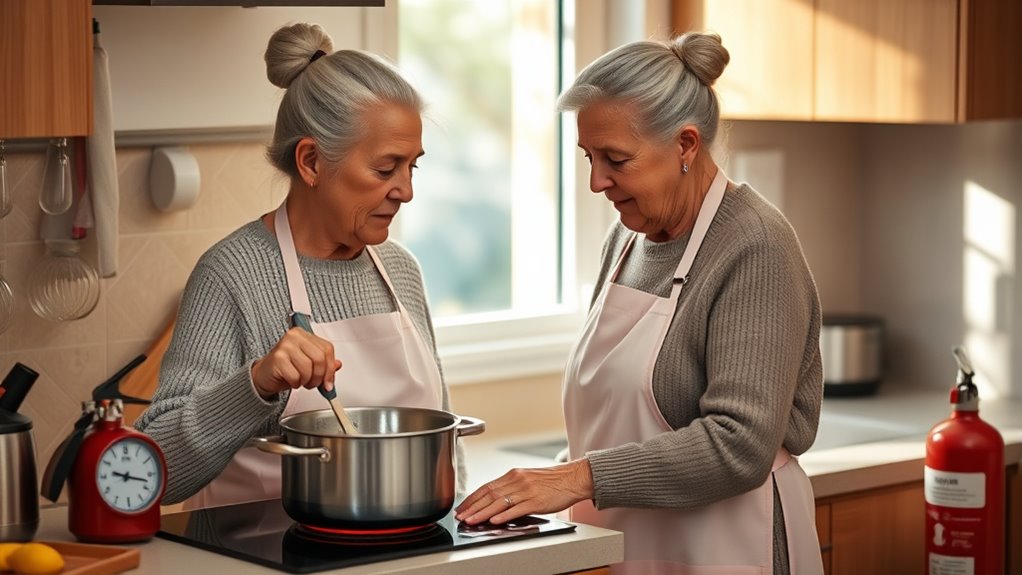To cook safely, keep flammable items like paper towels and cloths away from your stove, and always stay attentive while cooking. Use timers to prevent overcooking, and keep your kitchen clean to avoid grease buildup. Wear fitting, fire-resistant clothing, and never leave food unattended on the burner. Make sure smoke detectors work properly and have a fire extinguisher nearby. Following these tips can help protect you; more safety practices await you.
Key Takeaways
- Keep flammable items away from the stove and maintain a clutter-free cooking area.
- Install and regularly test smoke detectors; ensure proper placement for early fire detection.
- Use timers to prevent overcooking and wear fire-resistant clothing while cooking.
- Keep a fire extinguisher accessible and know how to use it in case of fire emergencies.
- Store kitchen items safely, organize storage, and maintain cleanliness to reduce fire hazards.
Keep Flammable Items Away From the Stove

To reduce the risk of kitchen fires, always keep flammable objects like paper towels, dishcloths, oven mitts, and plastic utensils away from the stove. These common household items are flammable objects that can easily catch fire if they come into contact with heat or an open flame. Stovetop hazards increase when such items are left nearby, especially if you get distracted or forget they’re there. Always clear the area around your burners before cooking, and avoid placing anything that can ignite near your stovetop. Use a designated space for cooking tools and keep flammable objects stored safely away. Staying vigilant about stovetop hazards can considerably lower your risk of accidental fires while cooking. Incorporating curiosity about safety can help you stay alert and proactively prevent potential hazards in the kitchen.
Use Timer Alerts to Prevent Overcooking
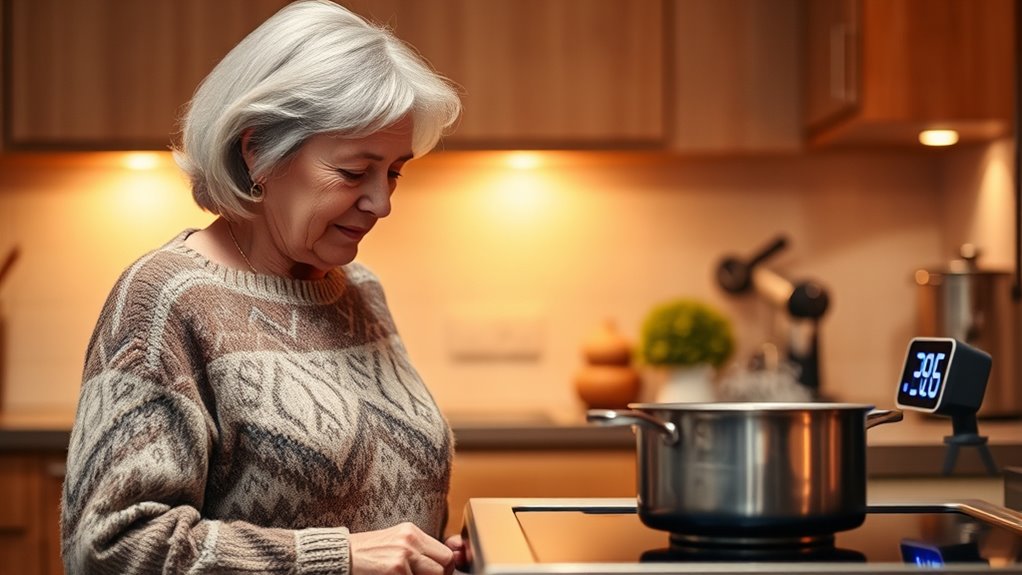
Setting a timer while cooking is one of the simplest ways to prevent overcooking and reduce fire risks. Using a smart timer with alert reminders guarantees you stay on track without constant attention. Here are four benefits of using timer alerts:
- Avoid Burnt Food — alerts notify you when cooking time ends, preventing overcooking.
- Enhance Safety — reduces the chance of unattended stove fires.
- Simplify Cooking — frees you to focus on other tasks or rest.
- Reduce Stress — knowing you’ll get an alert helps you stay relaxed while cooking.
Additionally, choosing a timer with high accuracy and reliability ensures you receive timely alerts, further safeguarding your home and peace of mind.
Maintain a Clean Cooking Area

Keeping your cooking area clean helps prevent accidents and fires. Make sure to clear your counter space, regularly wipe down surfaces, and store items safely away from heat. Staying organized reduces clutter and keeps you safe while cooking. Using proper tools and equipment, such as fire-resistant mats and smoke detectors, further enhances safety.
Clear Counter Space
A cluttered counter can increase the risk of accidents while cooking, making it essential to maintain a clean and organized space. Clearing your counter reduces counter clutter and helps you work safely and efficiently. Proper appliance arrangement ensures everything you need is within reach, without overcrowding your workspace. To keep your counter clear, consider these tips:
- Remove unnecessary items after each use.
- Designate specific spots for appliances and tools.
- Store rarely used items elsewhere, like cabinets.
- Keep frequently used items handy but organized.
- Regularly assess and adjust your space to prevent clutter buildup and maintain safety.
Regularly Clean Surfaces
Regularly cleaning your cooking surfaces is essential to prevent the buildup of bacteria, grease, and food crumbs that can cause accidents or illness. Consistent surface sanitation reduces the risk of fires and cross-contamination. Make it a habit to wipe down counters, stovetops, and cutting areas after each meal. Use safe cleaning products suitable for your surfaces, and don’t forget to scrub stubborn spots. Proper cooking surface maintenance keeps your kitchen safer and more hygienic. Pay close attention to spills and residue, as they can become slippery or ignite if left unchecked. Regular cleaning also helps you spot potential hazards early, like damaged or worn areas. Staying diligent with surface sanitation creates a cleaner, safer environment, giving you peace of mind during your cooking routines. Silly tantrums or pets stealing the spotlight can sometimes add humor, but maintaining a clean surface keeps things safe regardless of unexpected antics.
Store Items Safely
Storing items safely helps keep your cooking area organized and reduces the risk of accidents. Proper food storage prevents spoilage and keeps pests away, while good pantry organization makes cooking easier and safer. To improve safety and efficiency, consider these tips:
- Use clear, labeled containers for dry goods to easily identify contents.
- Store heavy items on lower shelves to prevent falls.
- Keep raw meats separate from other foods to avoid cross-contamination.
- Regularly check expiration dates and discard expired products promptly.
- Implement proper storage techniques to maintain the quality and safety of your food.
Wear Appropriate Clothing While Cooking

When cooking, choose clothing made from fire-resistant fabrics to reduce your risk of burns. Avoid wearing loose or flammable clothing that can catch fire easily. Staying mindful of your attire keeps you safer in the kitchen. Additionally, wearing appropriate clothing can help prevent accidents and injuries while cooking.
Choose Fire-Resistant Fabrics
Have you considered how your clothing can impact your safety while cooking? Choosing the right fabrics can make a big difference. Fire-resistant fabrics and flame retardant textiles are designed to resist ignition and slow flame spread, giving you extra protection. Here are four tips to help you select safer clothing:
- Opt for natural fibers like cotton or wool, which are less flammable than synthetics.
- Look for garments made from flame retardant textiles for added safety.
- Avoid loose or flowing clothing that can catch fire easily.
- Check clothing labels for fire-resistant features before cooking.
Wearing fire-resistant fabrics helps reduce the risk of burns. Always prioritize clothing that offers better protection in the kitchen.
Avoid Loose, Flammable Clothing
Wearing loose or flowing clothing while cooking can substantially increase your risk of accidental fires. Loose clothing hazards include fabrics that can easily catch fire if they come into contact with open flames or hot surfaces. Flammable fabric risks are especially high with long sleeves, loose sleeves, or garments made from lightweight or synthetic materials. To stay safe, choose snug-fitting or short-sleeved clothing that won’t dangle near the stove. Keep scarves, aprons, and other loose accessories away from heat sources. Always be mindful of your clothing when working around open flames or hot cookware. Additionally, selecting appropriate fabrics that are less likely to ignite can further reduce danger. By avoiding loose, flammable clothing, you reduce the chance of clothing catching fire and improve your overall kitchen safety. This simple step can prevent serious accidents and keep you safe while cooking.
Never Leave Cooking Unattended
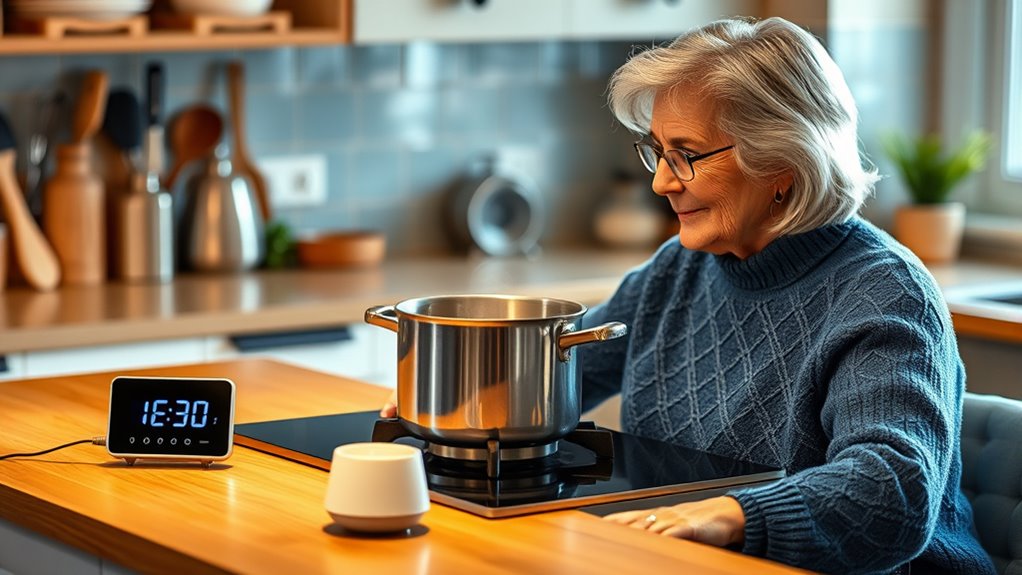
Leaving the stove or oven unattended can lead to accidental fires and serious injuries, especially for seniors who may have slower reaction times or diminished awareness. To guarantee kitchen safety, never leave cooking food without supervision. An unattended flame or hot appliance can quickly cause a fire. Keep these safety tips in mind:
- Stay in the kitchen while cooking, especially with high heat.
- Set timers as reminders to check on your food.
- Keep flammable items away from stovetops.
- Have an emergency plan ready in case of fire.
- Understanding the importance of digital literacy can help seniors access safety resources and emergency information quickly.
Practicing these habits improves your emergency preparedness and reduces fire risks. Always stay attentive during cooking to prevent accidents and protect yourself and your home. Remember, vigilance is key to safe and smart cooking.
Install and Regularly Check Smoke Detectors
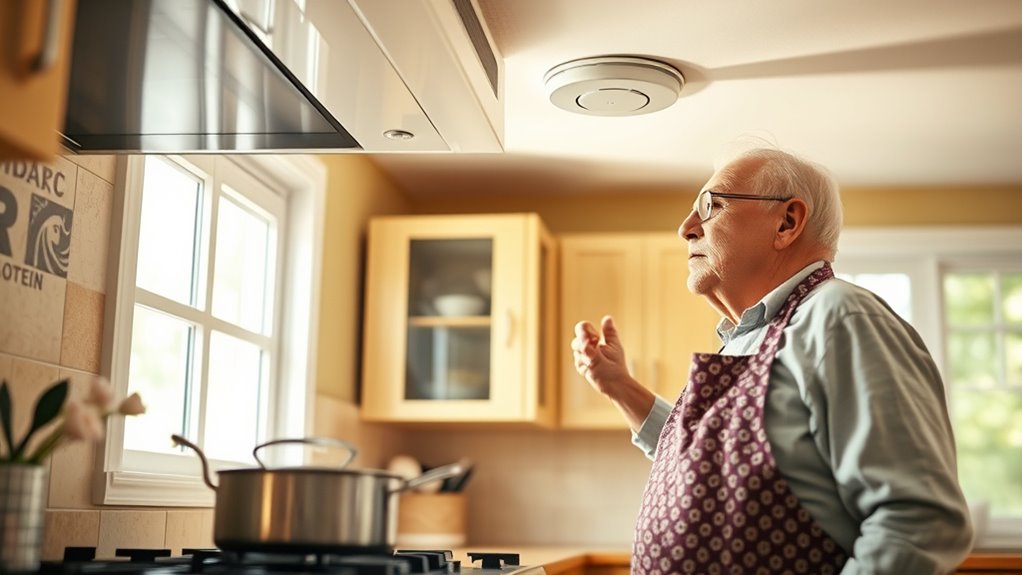
Installing smoke detectors in key areas of your home is vital for early fire detection and safety. Proper detector placement ensures you’re alerted quickly if a fire starts, especially in the kitchen or sleeping areas. Make sure smoke detectors are installed on every level of your home and outside sleeping spaces. Regular smoke detector maintenance is essential — test them monthly and replace batteries at least once a year. Change the detectors every 8-10 years or as recommended by the manufacturer. Keep detectors free of dust and debris, and avoid placing them near vents or windows that might trigger false alarms. Staying proactive with smoke detector upkeep can greatly reduce fire risks and give you peace of mind while cooking and throughout your daily routine. Additionally, being aware of fire safety tips can help you respond effectively in emergencies.
Keep a Fire Extinguisher Accessible in the Kitchen
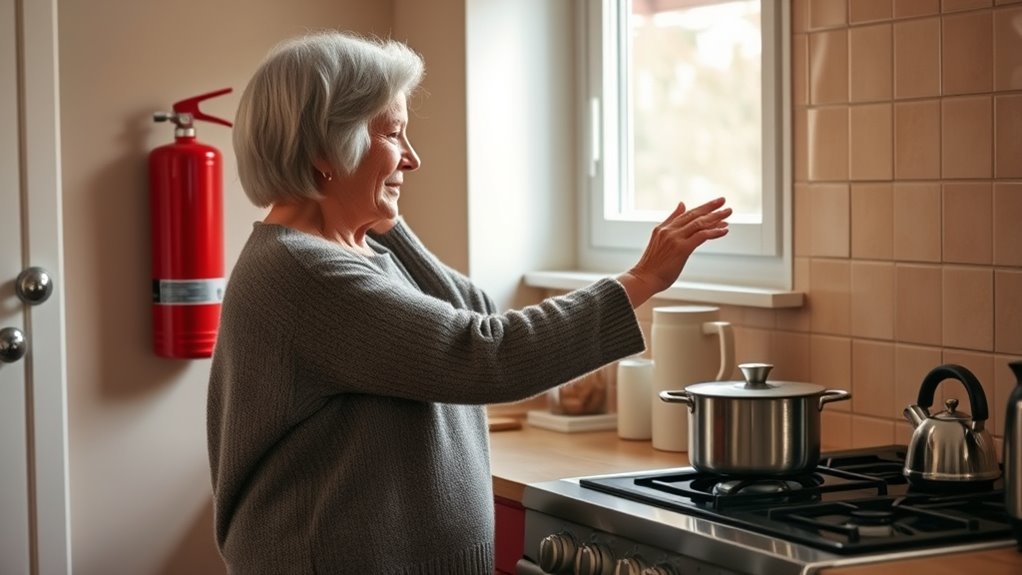
Keeping a fire extinguisher within easy reach in the kitchen is essential for quick response if a fire starts while cooking. Being prepared with the right equipment can prevent minor incidents from becoming disasters. Make sure your fire extinguisher is rated for kitchen fires (Class K or ABC), and know how to use it through fire extinguisher training. Keep it near exits or on a wall where it’s visible and accessible, not in cabinets or behind appliances. Regularly check the pressure gauge and inspect for damage to ensure it’s ready to use. Incorporate this into your emergency preparedness plan, practicing how to grab and operate the extinguisher quickly. A small step that provides peace of mind and safety during your cooking routines.
Frequently Asked Questions
How Can I Adapt My Kitchen for Better Fire Safety as I Age?
You can improve your kitchen’s fire safety by ensuring fire extinguisher placement is accessible, ideally near the exit or cooking area. Use stove safety features like automatic shut-off devices and burner safeguards to prevent accidents. Regularly check your appliances for damage and keep flammable items away from heat sources. These adjustments make your kitchen safer as you age, helping you cook confidently and reduce the risk of fires.
What Are Signs of Potential Fire Hazards in My Cooking Area?
You should stay alert for fire hazard awareness by regularly checking your kitchen for safety signs like frayed cords, grease buildup, or clutter near heat sources. Look out for signs of malfunctioning appliances or unattended cooking, which can increase fire risks. Keeping your kitchen organized and well-maintained helps you spot potential hazards early, ensuring your cooking area remains safe and reducing the chance of accidental fires.
Are There Special Fire Safety Devices Designed for Seniors?
They say prevention is better than cure, so it’s wise to explore senior fire devices. You can find specialized senior safety equipment like easy-to-use smoke alarms, thermal detectors, and automatic shut-off devices designed for seniors’ needs. These devices help reduce fire risks and provide peace of mind. Investing in senior fire devices guarantees your safety and independence, making your home a safer place to cook and live confidently.
How Often Should I Replace Smoke Detector Batteries?
You should replace your smoke detector batteries at least once a year to guarantee proper smoke detector maintenance. Follow a consistent battery replacement schedule, like doing it during daylight saving time changes, so you don’t forget. If your smoke detector chirps or the alarm doesn’t sound, replace the batteries immediately. Regularly testing your smoke detector is also essential for safety, giving you peace of mind that it’s working when you need it most.
What Steps Should I Take After a Small Kitchen Fire?
After a small kitchen fire, you should first make sure everyone is safe and then use a fire extinguisher if it’s still manageable. Remember fire extinguisher use properly—aim at the base of the flames and sweep side to side. Once the fire is out, ventilate the area and contact emergency services if needed. Finally, inform your emergency contact about the incident and have a professional inspect for damages.
Conclusion
By following these fire-smart cooking tips, you can keep yourself safe in the kitchen. Did you know that seniors are 2.5 times more likely to experience a kitchen fire? Staying alert, keeping flammable items away, and having safety devices like smoke detectors and fire extinguishers can make all the difference. Take these simple steps today to protect yourself and enjoy cooking with confidence and peace of mind.
